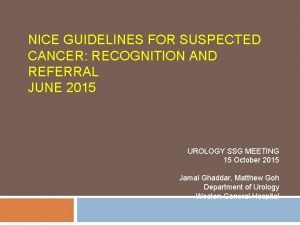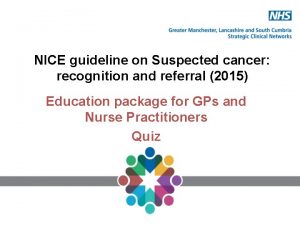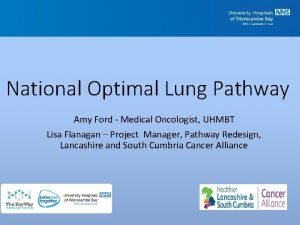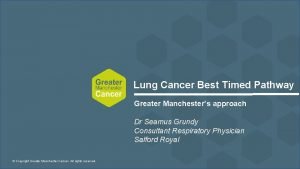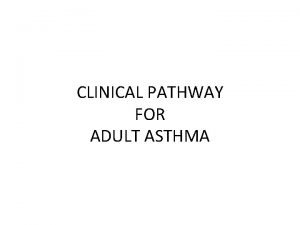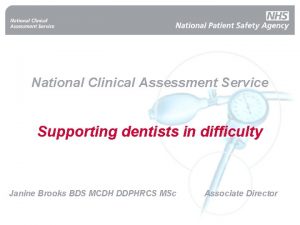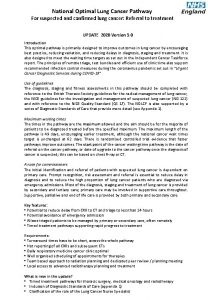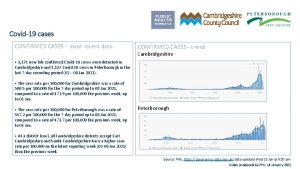National Clinical Pathway for suspected and confirmed lung







- Slides: 7

National Clinical Pathway for suspected and confirmed lung cancer: Detail of referral to treatment Note: this was previously circulated for discussion as an “optimal” pathway but following discussion and feedback has been designated the standard pathway Summary The National Clinical Pathway represents a pathway that is achievable now, requiring no extra resources but reliant on appropriate logistics. The triage process may be new for some services, but in the face of increased referrals and lower conversion rates, will reduce the cost to commissioners whilst supporting the drive to improve early diagnosis rates. The curative intent treatment pathway is shown separately, in more detail, for secondary and tertiary care providers. In some services early referral to a tertiary unit may occur for management of the diagnostic and staging pathway, especially where there is the potential for curative intent treatment. Use of guidelines The diagnosis, staging and fitness assessments in this pathway should be completed with reference to the British Thoracic Society guidelines for the radical management of lung cancer and the NICE guidelines for the investigation and management of suspected lung cancer. Maximum waiting times The times in the pathway are the maximum allowed and should be substantially lower for the majority of patients, with treatment started well before day 62. There is randomised controlled trial evidence that faster pathways improve outcomes. Providers: a note for commissioners The initial identification and referral of patients with suspected lung cancer is dependent on primary care. Prompt recognition, risk assessment and referral is essential to reduce delay in diagnosis and to reduce the high proportion of lung cancer patients who are diagnosed via emergency admissions. The majority of the lung cancer diagnostic, staging and treatment is provided by secondary and tertiary care, although primary care may be involved in providing supportive care throughout. Supportive, palliative and end of life care is provided by both primary and secondary care. Direct to CT option The direct to CT element of the pathway reflects that some services are piloting the direct requesting of CT scans by GPs according to local protocols. This may be in patients with relatively low incidence of lung cancer so that they do not need to be seen in cancer clinics e. g. normal chest X-ray with resolved symptoms, or for high risk people, again according to locally agreed protocols. It should be noted that evidence for this approach is limited and some models are being evaluated as part of the Accelerate Coordinate and Evaluate (ACE) programme.

National Clinical Pathway for suspected and confirmed lung cancer: Detail of referral to treatment Throughout pathway: • consider entry into a research trial • offer supportive & palliative care, e. g. by LCNS, GP, specialists in palliative care • encourage smoking cessation GP via NICE guidelines Maximum times Day 0 No Local protocol for direct to CT? FAST TRACK referral (suspected lung cancer) Yes CT abnormal? Arrange CT if clinically indicated; inpatients seen within 48 hours by acute oncology, respiratory or palliative services No CT suspicious of lung cancer? CT not indicated Yes CT Routine GP referral Hospitals referrals (A&E, internal or incidental findings) for suspected lung cancer Yes No Manage TRIAGE (by radiology or respiratory medicine according to local protocol) Lung cancer suspected? Yes Day 14 No Lung cancer unlikely* Further management according to local protocol with options of further management of CT findings by primary care or secondary care (see separate detailed algorithm) Fast track lung cancer clinic. Meet LCNS. Diagnostic process plan / diagnostic planning meeting prior to clinic Treatment of co-morbidity and palliation / treatment of symptoms Suitable for potentially curative treatment? * Yes No Will pathological diagnosis influence treatment and is potential treatment appropriate to patient’s wishes? No Yes Curative Intent Management pathway+ Test bundle requested at first OPA including at least: PET-CT and as required: detailed lung function and cardiac assessment / ECHO. Meet with LCNS and receive information Yes Further investigation(s) indicated? Investigations to yield maximum diagnostic AND staging information with least harm. Results available within 5 days for subtype and 14 days for molecular markers. Clinical diagnosis or patient preference means biopsy not required. No Day 28 Full MDT discussion of treatment options Yes Further investigation(s)? No Further discussion needed? No cancer: Manage/discharge No Follow-up Lung Cancer Clinic Cancer Confirmed and treatment options discussed. Research trial considered. LCNS present OPA with treating specialist (within 5 days) Day 33 Day 42 Further investigation(s)? *Refer to further pathway detail Yes + Low threshold for curative intent pathway; may discuss with wider MDT if unsure No Day 62 Maximum times First Treatment Specialist palliative care Other palliative treatments Chemotherapy Radiotherapy Surgery $ Some or all diagnosis and staging tests may be in a tertiary centre

National Optimal Clinical Pathway for suspected and confirmed lung cancer: Referral to treatment Note: this was previously circulated for discussion as an “aspirational” pathway but following feedback has been designated the optimal pathway Summary This optimal pathway is designed to meet the waiting time targets as set out in the Independent Cancer Taskforce report. In addition it will reduce delays within primary care relating to chest X-ray reporting and referral times with a potential to shorten the time to diagnosis by 2 to 4 months. This is because we know that in England, chest X-ray rates increase substantially from 4 months prior to diagnosis of lung cancer. Use of guidelines The diagnosis, staging and fitness assessments in this pathway should be completed with reference to the British Thoracic Society guidelines for the radical management of lung cancer and the NICE guidelines for the investigation and management of suspected lung cancer. Maximum waiting times The times in the pathway are the maximum allowed and the aim should be for the majority of patients diagnosed within 14 days and treated within 28. There is randomised controlled trial evidence that faster pathways improve outcomes. Providers: a note for commissioners The initial identification and referral of patients with suspected lung cancer is dependent on primary care. Prompt recognition, risk assessment and referral is essential to reduce delay in diagnosis and to reduce the high proportion of lung cancer patients who are diagnosed via emergency admissions. The majority of the lung cancer diagnostic, staging and treatment is provided by secondary and tertiary care, although primary care may be involved in providing supportive care throughout. Supportive, palliative and end of life care is provided by both primary and secondary care. Notes: • Potential for reducing delay from CXR to CT and clinic to less than 24 hours • Potential avoidance of emergency admission • Allows triaged patients to be managed by primary or secondary care (see separate algorithms) • Rapid progress to treatment Requirements: • Turnaround times have to be short, especially for radiology • Hot reporting of all CXRs and subsequent CTs • Daily respiratory medicine cancer clinic required

National Optimal Clinical Pathway for suspected and confirmed lung cancer: Referral to treatment No CXR (reported before patient leaves dept. ) suspicious of lung cancer? Yes CT within 24 hours if clinically indicated; inpatients seen within 48 hours by acute oncology, respiratory and/or palliative services CT not indicated Day -3 -0 Urgent or routine CXR No NICE referral guidance Throughout pathway: • consider entry into a research trial • offer supportive & palliative care, e. g. by LCNS, GP, specialists in palliative care • encourage smoking cessation Yes Hospitals referrals (A&E, internal or incidental findings) for suspected lung cancer Direct referral criteria (NICE) Maximum times High clinical suspicion? GP CT same day / within 72 hours No CT abnormal? CT suspicious of lung cancer? Yes No Yes Day 0 -3 TRIAGE (by radiology or respiratory medicine according to local protocol) Lung cancer suspected? Yes Day 1 -5 Manage No Lung cancer unlikely Further management according to local protocol with options of further management of CT findings by primary care or secondary care (see separate detailed algorithm) Fast track lung cancer clinic. Meet LCNS. Diagnostic process plan / diagnostic planning meeting prior to clinic Treatment of co-morbidity and palliation / treatment of symptoms Suitable for potentially curative treatment? + Yes No Curative Intent Management pathway* Test bundle requested at first OPA including at least: PET-CT and as required: detailed lung function and cardiac assessment / ECHO. Meet with LCNS and receive information. Further investigation(s) indicated? Will pathological diagnosis influence treatment and is potential treatment appropriate to patient’s wishes? No Yes Investigations to yield maximum diagnostic AND staging information with least harm. Results available within 3 days for subtype and 10 days for molecular markers. Clinical diagnosis or patient preference means biopsy not required. No Day 21 Full MDT discussion of treatment options Yes Further investigation(s)? Yes No Day 28 Further discussion needed? No cancer: Manage/discharge No Follow-up Lung Cancer Clinic Cancer Confirmed and treatment options discussed. Research trial considered. LCNS present Day 33 OPA with treating specialist (within 3 working days) Day 42 Further investigation(s)? *Refer to further pathway detail Yes + Low threshold for curative intent pathway; may discuss with wider MDT if unsure No Day 62 Maximum times First Treatment Specialist palliative care Other palliative treatments Chemotherapy Radiotherapy Surgery $ Some or all diagnosis and staging tests may be in a tertiary centre

Triage system for referrals to the lung cancer service: secondary care leads the management process This pathway places the responsibility for managing all patients referred for suspected lung cancer within secondary care. It ensures patients with other conditions that may require secondary care given appointments and patients not requiring secondary care directed back to primary care without the need for an outpatient appointment in secondary care. TRIAGE Respiratory physician triages with reported CT according to clinical and radiological features Lung cancer likely? Yes Fast track lung cancer clinic. Meet LCNS. Diagnostic process plan / diagnostic planning meeting prior to clinic. Treatment of co-morbidity and palliation / treatment of symptoms. No Non lung cancer pathway Respiratory condition requiring urgent appointment including other cancer? Yes Lung cancer pathway No Urgent respiratory clinic or other fast track cancer referral Urgent nonrespiratory condition? Yes Urgent communication with GP or direct admission depending on condition found or suspected No Ongoing symptoms / need for non-urgent respiratory OPA? Write to GP and patient Yes Non-urgent respiratory OPA Including management of pulmonary nodules No GP meets/communicates with patient. Still requires respiratory OPA? Yes No GP manages patient Recommendations for the management of pulmonary nodule can be found in the British Thoracic Society guidelines on the investigation and management of pulmonary nodules

Triage system for referrals to the lung cancer service: primary care leads the management process This pathways places the responsibility for managing patients that are unlikely to have lung cancer within primary care following a CT report that is not suspicious for lung cancer. This means fewer non-lung cancer patients are seen by the lung cancer services but relies on management of other conditions in primary care. TRIAGE Radiologist (with or without respiratory physician input triages according to CT findings Yes Fast track lung cancer clinic. Meet LCNS. Diagnostic process plan / diagnostic planning meeting prior to clinic Treatment of co-morbidity and palliation / treatment of symptoms Lung cancer pathway No Non lung cancer pathway Condition requiring urgent appointment including other cancer? Yes No Refer for urgent clinic / admission or other fast track cancer referral Non-urgent condition? Yes Manage in primary care or non-urgent referral Management of pulmonary is included here No GP manages patient Recommendations for the management of pulmonary nodules can be found in the British Thoracic Society guidelines on the investigation and management of pulmonary nodules.

National Optimum Curative Intent Management Pathway Detail Patients who are potentially suitable for curative treatment often require a complex combination of investigations to ensure they are accurately diagnosed, staged and their fitness assessed. This means they are more likely to endure longer waits for treatment. Hospitals face different challenges owing to variability in capacity to provide different investigations. The aim of this pathway is therefore to fast track such patients by requesting tests concurrently, supported by pre-planned availability of urgent test appointments e. g. lung biopsy, bronchoscopy, endobronchial ultrasound, mediastinoscopy, ECHO and complex lung function. Reference should be made to the British Thoracic Society guidelines for the radical management of lung cancer and the NICE guidelines for the investigation and management of suspected lung cancer. To prevent delays in treatment, consider early notification of thoracic surgeons or clinical oncology to help with scheduling Fast track lung cancer clinic ± diagnostic planning meeting / Diagnostic MDT Meet lung cancer nurse specialist Stage: Potentially T 1 -3 N 0 -2 M 0 (N 2 non-bulky; i. e. <3 cm) Or locally advanced; potential for radical RT? May include selected patients with oligometastatic disease No Yes Potentially fit enough for treatment with curative intent and willing to consider this? (Ensure low threshold for proceeding with work up for curative treatment) No Yes Simultaneous fast track: Patients with borderline fitness $ add: • Preoperative rehabilitation • Shuttle walk test / CPEX / ECHO • Perfusion scan if required • Early cardiology assessment for cardiac co-morbidity All patients: • Medical optimisation (incl. smoking cessation) • PET-CT (within 5 days) • Diagnostic and staging tests • Spirometry ±TLCO • Complete all tests within 14 days • Alert surgeons / clinical oncology Usual diagnosis and staging pathway Full MDT Discussion of treatment options or further investigation Yes Further investigation(s)? Yes No Follow-up Lung Cancer Clinic Further discussion needed? No Cancer Confirmed and treatment options discussed. Research trial considered. LCNS present OPA with treating specialist (within 3 days) Yes Further investigation(s)? No First Treatment $There is no agreed definition of borderline fitness. NICE QS 17 (Lung Cancer) defines this as a level of fitness that could lead to a greater than average morbidity or mortality from surgery. However, modern radiotherapy techniques mean that assessment for curative treatment can be applied at lower levels of fitness than defined in QS 17.
